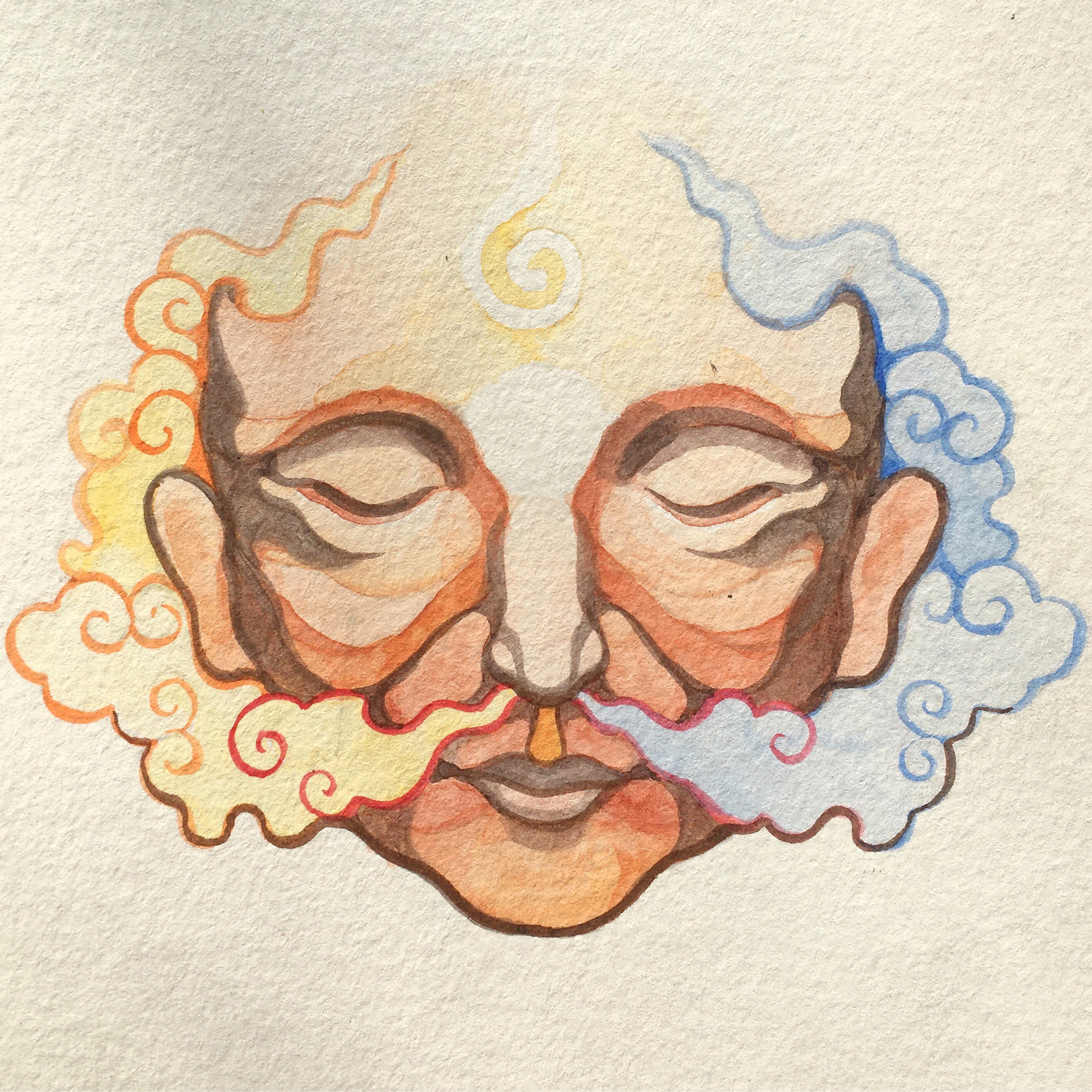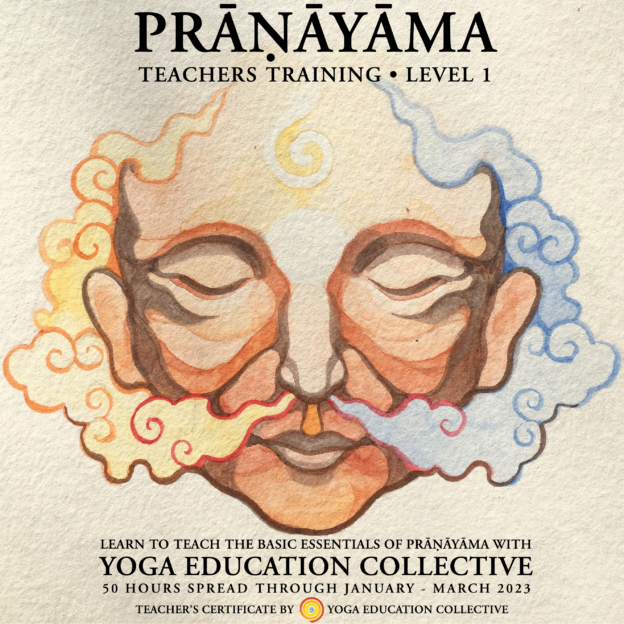This Course was Live in early 2023. This is a full replay for Self Paced Learning (SPL).
Click the ‘+’ signs to expand the headings to learn more…
Why a Pranayama Teacher Training?
Pranayama is a foundational practice of both the Ashtanga and Hatha schools of Yoga that prepares the body, nervous system, and mind for one-pointed concentration, leading to deeper levels of realization about oneself. In the majority of yoga classes that one currently encounters in the West, there is typically more emphasis on asana and less on pranayama. A standard ratio of pranayama to asanas given in traditional teachings is that we should spend half of the amount of time in pranayama that we spend doing asanas, and the same amount of time meditating that we spend in pranayama. So, if we spend one hour doing asanas, there should be thirty minutes of pranayama and thirty minutes of meditation. Most current yoga systems do not meet this criterion, and so the practices can begin to favor physicality over spiritual development.
List of Subjects that we will cover.
- History and definitions of Pranayama
- Sariras and Panchakoshas (3 Bodies and 5 Sheaths)
- Nadis & Chakras
- Anatomy and physiology of breathing
- Mechanisms of breathing
- Breathing muscles & pressure changes
- The Nose & Nostrils – Organ of Breathing
- The Lungs – Organ of Gas Exchange
- Regulation of Breathing
- Oxygen, Carbon Dioxide and Nitric Oxide & Blood pH levels
- Overview of the nervous system (CNS/ANS/Peripheral)
- The Vagal Nerve Complex
- Heart Rate Variability
- Level 1 Pranayama Class protocol
- Systematic course on essential Pranayamas
- Instructions on how to practice
- Practical teaching methods
- Effects on the body/mind
- Indic Philosophies
- Sankhya
- Yoga Sutras of Patanjali
- Advaita Vedanta
- Hatha Yoga Texts
- Hatha Yoga Pradipika
- Gheranda Samhita
- Siva Samhita
- Additional Pranayama practices
- Rose Breathing
- Kapola Shakti Vardhaka
- Ujjayi Pranayama
- Alternate Nostril Breathing with bandhas
- Shatkarmas (Shat Kriyas) Neti, Tratak, Nauli, Kapalabhati
- Major Mudras & Bandhas in Hatha Yoga
- Lifestyle Issues
- Sleep
- Diet
- Mantras for Pranayama
- So’ham
- Shreem and Hreem
- Sunrise Gayatri mantra
- Practice and Teaching
- What gives success in Yoga
- Obstacles in Yoga
- Tips for teaching
- Teaching Best Practices/How to present the practices
- What to look out for
- Language to use and not use
- Personal experiences
- Becoming a teacher
- Resources & reminders
- Practice and repetition
- Frequently Asked Questions
- Saints and Sages of India
- Convocation address of Taittiriya Upanishad
Who is this training for?
This training is meant to increase your knowledge of pranayama for both personal practice and for teaching. It is designed for yoga students who want to learn more about pranayama and yoga teachers who would like to learn how to safely teach pranayama to beginners. Psychologists, psychoanalysts, therapists, and well-being professionals are increasingly using breath-based practices for their patients, and the pranayamas that you’ll learn in this course will expand your vocabulary and tool kit on breath- and awareness- based practices for therapeutic means as well. Many yoga teacher trainings develop our knowledge of asana practices, but do not always go into the same depth for pranayama. This training will increase your knowledge of specific pranayama practices and protocols, and include information on the breadth of pranayama practices and its history. This course will give you many more hours of practice and class time to lift up your confidence and comfort level with pranayama.
Isn’t pranayama advanced or dangerous?
There is an idea that is prevalent that pranayama can be dangerous for you if you do too much of it or if you do it incorrectly. While this is true, it has led to less pranayama being practiced. This is unfortunate because pranayama is indeed extremely good for us, and when done in the right way – incrementally and gently – is beneficial for beginners and even people who are not necessarily practicing many asanas. In this training, we aim to teach you how to safely practice and teach some easy and essential pranayama practices. By the end of the training, you will have the language, skills, and experience to begin sharing these practices with your friends, family, and students.
Some of the benefits of pranayama include:
- Increased cardiovascular health
- Increased respiratory health
- Decreased stress levels
- A calm mind
- A balanced nervous system
- Deepened inner awareness
- A way to prepare for meditation
- Improved digestion and elimination
- Mastery over the mind and emotions
- Increased energy levels
What will I learn?
You will learn a simple six-step protocol suitable for beginning students that is adaptable depending on the needs of the student. We will practice this protocol throughout the training, and you will have opportunities to practice teaching it to the other students for feedback and enhancing your comfort levels. It is a simple, safe, effective sequence of pranayamas that all have scientific research and hundreds of years of verified practice to back them up. We look forward to seeing you in the training! Please see Weekly Synopsis for more details.
The course is segmented into weeks. Subjects covered are:
- What exactly is pranayama
- Definitions of pranayama from Indian texts
- History of pranayama
- Sariras and Panchakoshas (3 Bodies and 5 Sheaths)
- Intro to basic Level 1 Pranayama Class protocol
- Special practices: Nadi Shuddhi (as per Hatha Yoga Pradipika)
- Helpful asanas will be incorporated throughout the 6 weeks:
- Shoulder rolls
- Neck stretches
- Ardha kati chakrasana
- Sheetala dandasana
- Ardha chakrasana
- Uttanasana
- Kati chakrasana
- Students begin teaching Level 1 Protocol
- Introduction to anatomy and physiology of breathing
- Mechanisms of breathing
- Breathing muscles & pressure changes
- Effects of the level 1 protocol
- The Lungs – Organ of Gas Exchange
- Regulation of Breathing
- Oxygen, Carbon Dioxide and Nitric Oxide & Blood pH levels
- Introduction to the Samkhya Philosophy
- Special practices: Nadi Samanu
- The nose, nostrils and the nasal cycle
- Regulation of breathing
- Introduction to Yoga Sutras
- Introduction to Hatha Yoga Pradipika
- Special practices:
- Increase Kapalabhati (1 minute pumping /1 minute sitting/3x)
- Ujjayi Pranayama
- Overview of the nervous system (CNS/ANS/Peripheral)
- The Vagal Nerve Complex (included in ANS)
- Nadis, granthis and the Nervous System
- Shatkarmas (Yogic cleansing exercises) Neti, Tratak, Nauli, Kapalabhati
- Special practices: Kapola shakti vardhaka, Karna shakti vardhaka, Ajagari
- Heart Rate Variability (HRV)
- The eyes and Tratak
- Mudras & Bandhas in Hatha Yoga Pradipika
- Diet, Lifestyle, Sleep
- What gives success in Yoga
- Obstacles in Yoga
- Special practices:
Sunrise Gayatri mantra (Weather permitting, Monday or Thursday)
Increase Brahmari
- Advaita Vedanta philosophy
- Darshan of sages and saints of India
- Special practices:
- Surya bhedana
- Sitali / Sitkari
- Sunrise Gayatri mantra (Weather permitting, Monday or Thursday)
- Becoming a teacher & Tips for Teaching
- Resources
- Practice and repetition
- Convocation address of Taittiriya Upanishad
About Instructor



